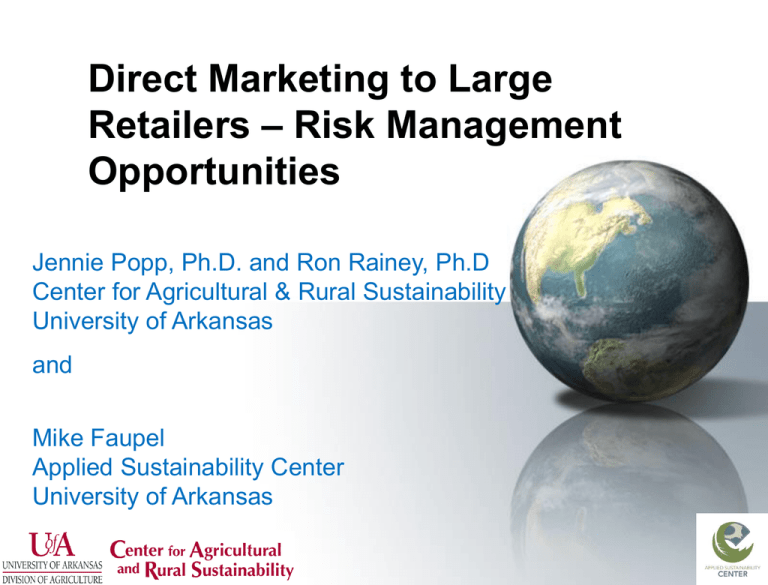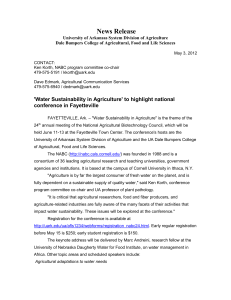NRMEpresentation - National Ag Risk Education Library
advertisement

Direct Marketing to Large Retailers – Risk Management Opportunities Jennie Popp, Ph.D. and Ron Rainey, Ph.D Center for Agricultural & Rural Sustainability University of Arkansas and Mike Faupel Applied Sustainability Center University of Arkansas Local Foods • Local food or local food movement is a collaborative effort to build more locally based, self reliant food economies – one in which sustainable food production, processing, distribution, and consumption is integrated to enhance the economic, environmental and social health of a particular place. Food Mile Facts • In the U.S. the average grocery store produce travels nearly 1,500 miles. • Approximately 40% of U.S. fruit is produced overseas. • Broccoli is grown an average of 20 miles of the average American’s house. • The average broccoli at grocery stores travel 1,800 miles. More Facts • Grocery stores produce purchases trickle down 3.5 cents of each dollar to the farmer. • A wheat farmer can expect to receive about six cents of each dollar spent on a loaf of bread. • Farmers Markets return is typically 80 to 90 cents of each dollar spent to the farmer. Why are Local Products More Popular? • Consumers are demanding and willing to pay a premium for local products • Producers are doing a better job of developing marketing strategies and demanding a bigger piece of the pie Its not always the best product, but the best marketed product that sells first • Drastic increase in fuel prices or transportation costs Changing Consumer Preferences for Local Products • Safety and quality perceptions play an important role in consumer acceptance • Freshness and taste influence consumer preference • “Home-bias” Support for local business or preserving agrarian way of life Consumers associate local food systems with the concept of “ environmental sustainability” Major Retailers Plan for Expanding Local Markets • Create current supply chain visibility to local and regional sources. Develop new local and regional sources. • Market local to our customers and educate on benefits. • Improve freshness with less road time and lead time • Ethnic Niches - Re-invigorate historic growing areas to grow items popular with the US’s growing minority communities near the consumer providing supply, freshness, & cost advantages. Major Retailers Plan for Expanding Local Markets • Retailer tracked the impact of local for a single product: • Increase in dollars sales of 21.54%. • Increase in units sold by 20.88%. • Sale-through increased by 3%. • Mark-downs decreased by 3.7%. Community Benefits from Local Foods • Farm diversification and sustainability • Increased jobs and income in community • Improved access to fresher foods • Greater traceability and choice • Decreased risk of widespread contamination • Environmental benefits such as reduced food miles Local/Regional Markets Can Be Risky • Perceptions exists that local markets provide safer food – not substantiated • Little focus on training small/mid-sized producers on food safety and recalls • Small/midsized producers are more vulnerable to risks that larger companies • They can be driven out of business easily and destroy the local/regional market Local Food Sourcing Methods • Older: farmers markets, farm/roadside stands, u-pick operations, community supported agriculture (CSA) • Newer: public schools, hospitals, institutions of higher education, food retailers (grocery and restaurant) – Market Maker and other electronic markets emerging Questions Arise: • Are farmers equipped to meet the demands of these emerging markets? • Does the infrastructure exist to connect buyers and sellers and to move products locally/regionally? The Food Marketing Chain Processing Production Distribution Direct Mktg Wholesale Consumption Retail Producer Faces Risks Throughout Chain Production Legal Environmental Financial Personnel Food Safety Processing Production Distribution Direct Mktg Food Safety Wholesale Consumption Marketing Legal Financial Food Safety Retail Goals Medium and Large Scale Buyers Facilitate the availability of safe, consistent and reliable supply of relevant products for purchase in the market by large scale buyers Agricultural Producers Identify risk mgt needs and develop risk mgt tools to enable producers to participate in direct marketing opportunities Enhanced Profitability and Market Sustainability Examples of Producer Challenges and Opportunities Little knowledge of: Needs to be met through: • Emerging markets where/how to enter • Development of new kinds of marketing plans (mktg risk) • Buyers needs and requirements space filler for this • Development of contract/ insurance/bonding tools (legal/financial risk) • State/federal regulation for direct marketing • Development of regs education (legal risk) • Emerging food safety concerns • Identification of BMPs (production risk) • Capital requirements • Development of new debt mgt tools (financial risk) The Approach – Step 1: Identify Needs • Engage representatives from all relevant parts of the supply chain and their supporters --- producers --- warehousing/storage --- input suppliers --- government --- transporters --- buyers --- ag lenders --- NGOs convene group and utilize their expertise to identify current barriers to a fully functioning local/regional food system The Approach – Step 2: Develop Tools • Lead a team of university, government and private industry experts to develop tools that fill the gaps. e.g. – Legal information related to regulations, estate planning, and insurance and their associated financial implications • New insurance tools for direct marketing – Financial information related to all debt management • New financing opportunities to support market infrastructure and production expansion – Marketing information related to marketing co-operatives, general contracting, minimum price contracting • New individual and collective selling strategies – Evaluation of potential new production areas • Seasonal land use changes in US The Approach – Step 3: Develop/Provide Training • To the producer – New risk management tools and lender/ buyer requirements • To the buyer – Means to reach potential sellers (availability of local markets throughout the year) • To the greater agricultural industry – Opportunities for agricultural lenders, input suppliers, market managers • To the trainers The Approach – Step 4: Facilitate Communication • Facilitate communication throughout the supply chain and to industry/government agencies that support agriculture – Meet current needs – Anticipate future needs Progress to Date Collaborations and Partnerships • Uniqueness of University of Arkansas – Center for Agricultural and Rural Sustainability – Cooperative Extension Service – Applied Sustainability Center – National Agricultural Law Center • Strong partnerships established with: – Industry – Walmart, C.H. Robinson, L & M Produce, Delmonte, Dole – Government - USDA RMA, Southern Risk Management Education Center, AR State Department of Agriculture, CSREES Program Leaders – Agricultural Lenders – Tribal Entities – Other Land Grant Universities – Marketmaker Step 1: Identify Needs • USDA RMA Partnership • Arkansas and Oklahoma Focus • Need for legal/marketing risk management tools for producers – Contracting – Direct marketing risk management – Engage producers in Arkansas and Oklahoma • Fact Sheets • Networking Development Step 1: Identify Needs • Walmart Supply Value Network • National Focus • Identification of producers to supply local stores and distribution centers – Initial success in Arkansas and with some Tribal entities • Merging of needs of retailers/consumers with needs of producers Step 1: Identify Needs • Survey of Horticultural Producers – – – – – Risk management needs Marketing outlets Contracting Familiarity with electronic markets Interest in marketing to large retailers Step 2: Develop Tools • Stakeholder Summit June 30-July 1, Fayetteville, AR • Land-grant universities, other academics, producers, retailers, distributors, NGO’s and CBO’s, and government • Goal: design and launch projects to bridge the gap between market demand for local/regional ag products and the current supply • Could include: – Legal information related to regulations, estate planning, and insurance and their associated financial implications – Financial information related to all debt management – Marketing information related to marketing co-operatives, general contracting, minimum price contracting – Evaluation of potential new production areas Step 3: Develop/Provide Training Currently: • To the producer – Legal aspects of contracts – Managing risks associated with direct marketing For the future: • To the buyer – Means to reach potential sellers (availability of local markets throughout the year) • To the greater agricultural industry – Opportunities for agricultural lenders, input suppliers, market managers • To the trainers The Approach – Step 4: Facilitate Communication • Facilitate communication throughout the supply chain and to industry/government agencies that support agriculture - developing a network of producers in Arkansas with Arkansas State Department of Agriculture - communicating through SVN meetings and producer meetings We Need You! • All are invited to work with University of Arkansas and its partners to develop and extend risk management materials for producers and to provide agricultural information to retailers and consumers • Please contact Jennie Popp (jhpopp@uark.edu) or Ron Rainey (rrainey@uaex.edu) to see what you can do! Interested in Attending the Summit? • We are seeking broad representation across both geographical area and expertise, thus space for any type of individual is limited • We are currently gathering potential stakeholder information • If you are interested, please contact Mike Faupel at mfaupel@walton.uark.edu. • The initial round of invitations will be made in mid-April Contacts for More Information Jennie Popp, Ph.D. jhpopp@uark.edu 479-575-2279 Ron Rainey, Ph.D. rrainey@uaex.edu 501-671-2175 Mike Faupel, M.S. mfaupel@walton.uark.edu 479-575-4594






